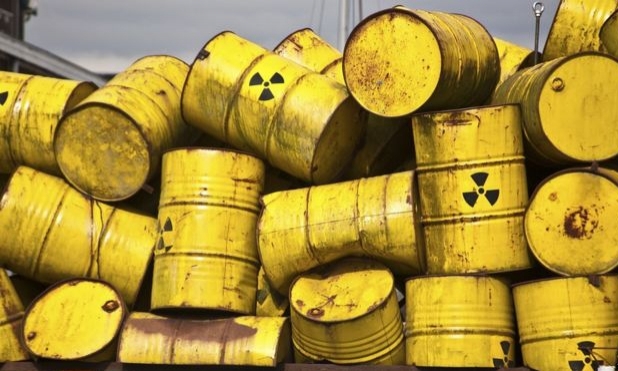 Illustration: Radioactive tank. (Image via BBC)
Illustration: Radioactive tank. (Image via BBC)
Japan should dump Fukushima's waste into the sea: Environment Minister
A move that will affect the sea ecosystem and fishermen’s livelihood, Japanese Minister of Environment, Yoshiaki Harada, stated that Tokyo Electric Power (Tepco) was running out of space to store radioactive waste from Fukushima’s nuclear reactors. Then, he offered one simple solution: dump it to the sea.In March 2011, an M9 earthquake that caused a tsunami shook the northeastern region of Japan, the worst natural disaster to ever hit the East Asia nation. The cooling systems in three reactors at Fukushima Daiichi nuclear plant were damaged, resulting in the leakage of radioactive materials.
Since then, Tepco has been pumping the water and put it into storage. Now, the storage is running out of space with almost 1,000 contaminated water tanks.
Moreover, these banks are still contaminated by several radionuclides such as tritium since Tepco does not have the technology to process the tritium out of the waters. Tepco, however, stated that they had gotten rid of the most radionuclides from the contaminated water.
According to research by radioactive experts, it will take about 17 years for this water to be diluted before being discharged into the sea. By summer 2022, there will be no room for any contaminated water tank.
“There is no option. Dump it into the sea and dilute it. The government has not thought about it yet, but it is my simple solution,” said Harada in an interview.
However, it was not the decision of the Japanese government. Japanese Chief Cabinet Secretary, Yoshihide Suga, described Harada’s comment about the waste as a personal opinion. The Japanese government is also required to keep in mind how the local fishermen had been struggling to re-establish their livelihood after the worst natural disaster.
Should they dump the radioactive waste into the sea, it will not be only the fishermen that will be enraged. The neighboring country, such as South Korea (S. Korea), is going to see red too.
In August, S. Korean Minister for Environmental Affairs, Kwon Se-jung, met with the Head of Economic Affairs at the Japanese Embassy in S. Korea, Tomofumi Nishinaga, to discuss the plan to dump the contaminated water into the Pacific Ocean.
S. Korea and Japan should be cooperating to seek ways to prevent the wastewater from affecting the lives of their fauna and people, suggested Kwon. Despite the trade row between the two nations, Japan and S. Korea should find a way to treat the water for the sake of their people.
“We have asked Japan to take a wise and prudent decision concerning the matter,” said S. Korean Ministry of Foreign Affairs in a statement.
The Japanese government had rolled out ¥34.5 billion to build a frozen wall underground to prevent the water to reach the three damaged reactors. However, it could only reduce the tank from 500 tons to 100 tons daily. Japan is required to solve this problem before 2020 when it is going to host the 2020 Summer Olympics and Paralympics.
Source: https://www.theguardian.com/environment/2019/sep/10/fukushima-japan-will-have-to-dump-radioactive-water-into-pacific-minister-says
 English
English Japan
Japan

water pill lasix furosemide 80 tablet furosemide 20 mg used for what are the side effects of taking lasix?
lasix medscape lasix cost lasix medicine for water retention where to buy lasix water pill
viagra dosage levels viagra trial samples viagra connect trulicity cost without insurance atorvastatin lipitor 40 mg tablet
allergy to amoxil buy amoxicillin online with paypal will amoxil treat strep throat symptoms of amoxicillin
extenze male enhancement pictures women viagra generic contacts interactions for cialis hilarious warning labels is viagra from mexico safe viagra price what milligrams does cialis come in can i take viagra women's viagra goodrx viagra are there substitutes for viagra code for walmart grocery pickup cialis vs viagra cialis 20mg tablets coupon genuine viagra 100mg how effective is cialis for daily use walmart prescription insurance otc viagra does womens viagra work cialis samples by mail cialis effectiveness over time cialis mexico safe viagra for men small blue pill for depression taking expired viagra cialis sample pack buy viagra online tadalafil on sale how to increase libido menopause walmart prescription list 2017 viagra side effects fda approved stimulants for children
buying zithromax online can you drink while taking zithromax what is azithromycin 250 mg for
wellbutrin and neurontin neurontin 300 mg capsule common side effects of neurontin what class drug is gabapentin
plaquenil allergic rash can i take tumeric and plaquenil how does plaquenil fight malaria
plaquenil monitoring is plaquenil-induced erythroderma reversible how long does plaquenil take to work for ra
azithromycin directions zithromax 1000 mg for sale is zithromax and azithromycin the same thing where to buy azithromycin over the counter
neurontin drug family neurontin india how to wean off gabapentin neurontin why can't you take antacids with gabapentin
amoxicillin substitute walgreens amoxicillin price amoxil adverse effects vs side effects amoxicillin and tylenol
neurontin vs gabapentin neurontin cost generic neurontin generic and trade name how do you spell gabapentin
male enhancement surgery walgreens coupons walgreens pharmacy prices cialis instant natural viagra natural vitamin supplements for women prescription drugs online without doctor
sanofi aventis plaquenil canadian pharmacy how long until plaquenil starts working plaquenil who makes
amoxicillin chlamydia treatment amoxicillin 500 mg price amoxicillin meaning motrin and amoxicillin
furosemide in pregnancy lasix 250 effects of furosemide on kidneys what does lasix do heart failure
neurontin side effects gabapentin 215 does neurontin show up on drug test what is in gabapentin 300mg capsules
vanilla bean flavor description over counter viagra walgreens does viagra work for men goodrx viagra sildenafil citrate 200mg pills 20 mg cialis reviews new viagra pill for women
what is neurontin gabapentin 400 mg pill neurontin 300 mg capsule for pain what does 600 mg gabapentin look like